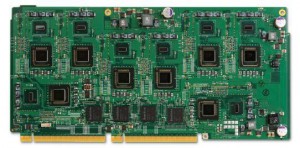SeaMicro’s Low Power Server SM10000
SeaMicro today unveiled a new low-power server that promises to slash power costs for companies running large Internet services and cloud computing platforms. SeaMicro’s multi-core x86 server runs on Intel’s low-power Atom chips, whose energy efficiency has made them the processor of choice for many mobile phones and laptops.The power profile of the SM10000 allows SeaMicro to pack 512 Atom CPUs into a 10U server, providing the option to fit as many as 2,048 CPUs into a single seven foot, 40U rack. The company says each of its servers use less than 2 kilowatts of power, suggesting that a rack filled with SeaMicro servers can have a power load of under eight kilowatts – a manageable power load for most data centers optimized for high-density computing.
It also includes a load-balancing feature called Dynamic Compute Allocation Technology (DCAT) that provisions traffic and workloads within the SM1000. This also provides power management advantages, allowing the server to focus workloads on a set of CPUs within the server while placing other CPUs in sleep mode to preserve power. ”A utilization threshold for a pool of compute can be set, and if met, CPUs can be dynamically added or removed from the pool,” SeaMicro says in its system overview.


System Details
Compute: In the SM10000, the basic building block is a credit cardsized
compute block, comprised of an Intel Atom CPU and its chipset,
DRAM, and a custom SeaMicro ASIC. All the other components normally
found on a standard motherboard have been removed by a patented
hardware-based CPU I/O virtualization technology. Eight of these
credit card-size blocks fit on a 5 x 11 inch motherboard (see figure
above); 64 of these hot-pluggable motherboards are packed into a 10
rack unit SM10000, for a total system density of 512 Atom CPUs.
Fabric Technology: SeaMicro has developed interconnect fabric
technology capable of linking together hundreds of these credit
card-sized compute building blocks. The fabric is contructed by
linking SeaMicro ASICs in a multi-dimensional torus. The fabric is
FLIT-based and wormhole routed, with integrated virtual channel
technology. The fabric has the ability to transmit and receive different
classes of traffic enabling both loss sensitive storage and loss
insensitive Ethernet traffic to be transferred on a single infrastructure.
These technologies combine to produce resilient, low-latency,
high-bandwidth links at very low cost while providing 1.28 terabitsper-
second of fabric bandwidth.
Storage and Disk:
The SeaMicro SM10000 can be configured with
0 to 64 2.5 inch SATA hard disk drives (HDD) or solid state drives
(SSD). The 512 CPUs in the system can be allocated portions of a disk
or whole disks. A physical disk (HDD or SSD) can be divided into
multiple virtual disks – from 2GB to the maximum capacity of the
disk – and assigned to one or more CPUs. Data resiliency is maintained
by marking a disk to be part of a RAID pool or by assigning
multiple disks to a CPU. The system can be configured to run with or
without disk, ensuring the flexibility to appropriately provision storage
for the desired applications.
A disk (either physical or virtual) can be configured to be in
“write” mode for one server and “read-only” mode for the other 511
servers, allowing users to store “read-only” copies of data to be
shared among multiple processors. Multiple “read-only” disks can
be created for redundancy or for different pools of CPUs. This
“read-only” disk enables data center operators to update software
for the entire system by updating the software just once – a huge
operational advantage over existing systems where an update is
required for each individual server.
Ethernet Uplinks:
SeaMicro Ethernet uplink cards provide uplinks
from the supercompute fabric to the external data center network
via 1 Gigabit Ethernet or 10 Gigabit Ethernet interfaces. The interfaces
support link aggregation (IEEE 802.3ad) with LACP both
within and across I/O cards, providing redundancy against link and
I/O card failure. In the SM10000, inter-server communication traffic
remains on the fabric and does not consume any uplink bandwidth,
enabling customers to configure uplinks to their core switches
based on the desired bandwidth.
The uplink cards also include a management processor and provide
a range of value-added features never before included in a server. For
example, algorithms running on the management processor and dedicated
hardware can implement MAC aggregation and hiding. This
enables the system to be configured to expose as few as one and as
many as 64 MAC addresses while continuing to provide an IP address
and a MAC address to each CPU (or virtual machine instance).
This isn’t something the average guy can use but it will sure help data centers reduce their power usage while maintaining a high level of availability and performance.



